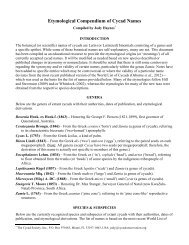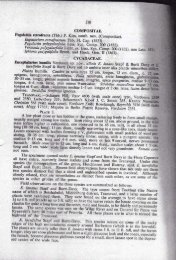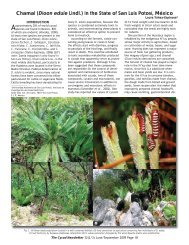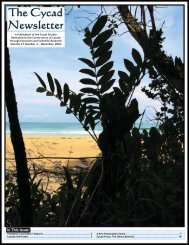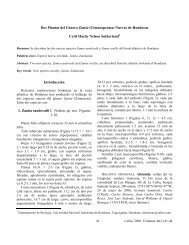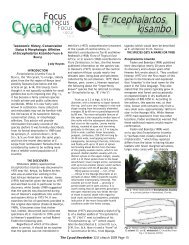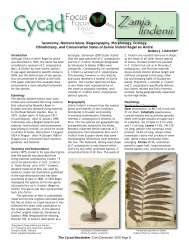In This Issue: - Cycad Society
In This Issue: - Cycad Society
In This Issue: - Cycad Society
You also want an ePaper? Increase the reach of your titles
YUMPU automatically turns print PDFs into web optimized ePapers that Google loves.
Zamia lindleyi in its cloud forest habitat<br />
of this new road, which was sure to<br />
bring a flood of people? Because of<br />
time constraints, we were not able to<br />
collect any specimens but we did<br />
allow ourselves the luxury of stopping<br />
to admire their magnificence� A little<br />
further along the road, we began to<br />
see the real quarry of our quest - Z�<br />
skinneri� Like garnet and ruby fountains<br />
in an emerald green sea, the<br />
massive new leaves arched skyward<br />
from trunks measuring a meter tall�<br />
Leaves were produced in numbers<br />
from one to five, but mostly in sets of<br />
three� Some leaves were over 2�5 m<br />
long with leaflets up to 60 cm long<br />
and 20 cm<br />
wide� The<br />
anthocyanins,<br />
which<br />
gave the<br />
new leaves a<br />
ruddy hue,<br />
stood out in<br />
stark contrast to the green forest<br />
behind�<br />
Once in the town of El Guabal,<br />
we quickly unloaded the trucks with<br />
the help of the entire town and<br />
headed into the forest� Zamias were<br />
very abundant and we soon had all<br />
the plants, herbarium vouchers, and<br />
DNA samples we needed� The steady<br />
rain that had accompanied us all day<br />
now became a downpour and we<br />
rushed to leave before the road<br />
became totally impassable� We arrived<br />
back in town as night fell—bruised,<br />
tired, and hungry, but giggling like<br />
school children at the day’s events�<br />
The next morning, we were up<br />
early, driving west to the town of<br />
Chiriquí, then turning north on one of<br />
only two roads to transect Panama<br />
from the Pacific to the Caribbean<br />
coast� Near midway along this road is<br />
the continental divide and the<br />
Fortuna Dam area� <strong>This</strong> is an incredibly<br />
diverse botanical region protected<br />
by the national park system of<br />
Panama� Here, in cloud forest at<br />
1,200 m elevation, we found the rare<br />
and beautiful Z� lindleyi� The plants<br />
Zamia pseudomonticola in volcanic soil near<br />
the Costa Rican border�<br />
The <strong>Cycad</strong> Newsletter Page 8<br />
were scattered sparsely along the top<br />
of the ridge� The trunks averaged<br />
about a meter tall, although all sizes<br />
from seedlings to much larger trunks<br />
were observed� Each plant held about<br />
five to six leaves per flush� New<br />
leaves were a bright shiny green; the<br />
older leaves were dull green and<br />
almost completely covered with<br />
bryophytes� A leaf was composed of<br />
20 to 30 pairs of narrow leaflets,<br />
each leaflet measuring 2�5 cm wide<br />
by about 20 cm long�<br />
As we continued down the<br />
mountain toward the town of Chiriquí<br />
Grande we again observed Z�<br />
pseudoparasitica� <strong>In</strong> the hills above<br />
the town, and along the costal road,<br />
which continues northwest to the<br />
Costa Rican border, we collected Z�<br />
neurophyllidia� <strong>This</strong> plant is described<br />
basically as a dwarf form<br />
of Z� skinneri� The emergent<br />
leaves of this species are bright<br />
green as opposed to the reddish<br />
bronze color of Z� skinneri, and they<br />
tend to sport twice as many leaves at<br />
any one time� Leaflets of Z�<br />
neurophyllidia are generally smaller<br />
and more numerous than those of Z�<br />
skinneri� However, we found some<br />
mature Z� neurophyllidia individuals<br />
with leaves over 2�2 m long and<br />
leaflets 15 cm wide by 50 cm long� We<br />
found at least one large female plant<br />
with a trunk over 3 m tall� <strong>This</strong> is<br />
much larger than any trunks of Z�<br />
skinneri that I have personally seen�<br />
Plants were abundant all throughout<br />
this area, but are being threatened by<br />
deforestation�<br />
Next, we headed to the barrier<br />
islands on the seaward side of Laguna<br />
de Chiriquí� We landed on the southern<br />
or mainland side of the island and<br />
made our way over the tall ridge that<br />
runs down the center and then started<br />
down to the northern side� At the<br />
bottom of the ridge was a low<br />
swampy area� From here, the ground<br />
rose gently but steadily toward the<br />
beach� It was here that I saw something<br />
that I will never forget� It was a<br />
forest of Z� neurophyllidia� <strong>This</strong> forest<br />
was narrow, starting at the beach and<br />
continuing back toward the swamp for<br />
maybe 100 meters� It continued for<br />
about 1�5 km and contained literally<br />
thousands of individuals, maybe tens<br />
of thousands of plants� Plants were in



